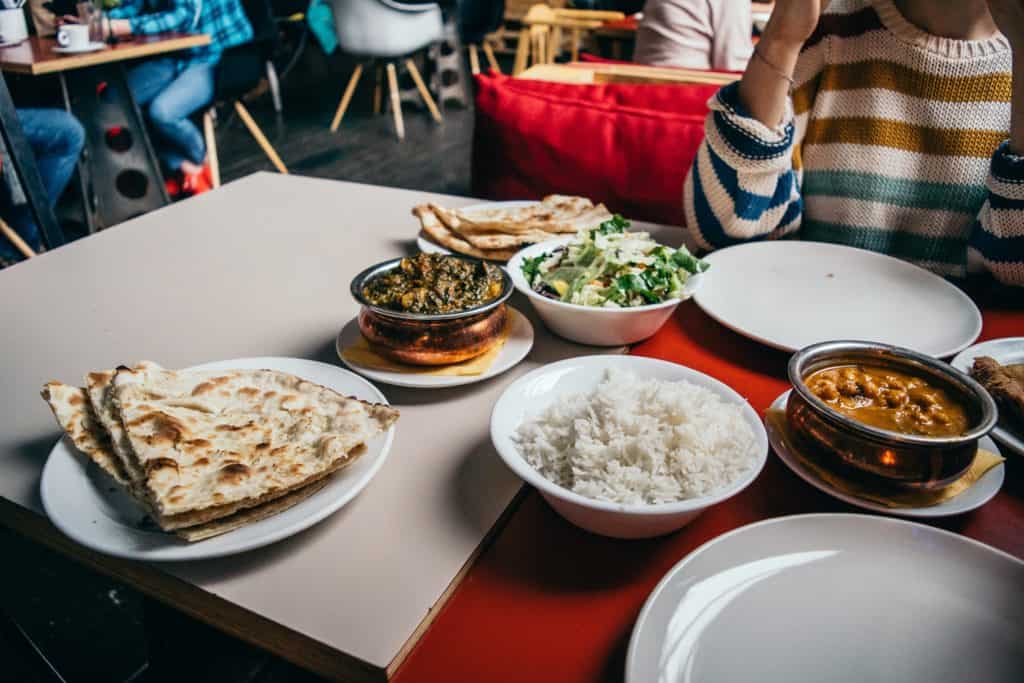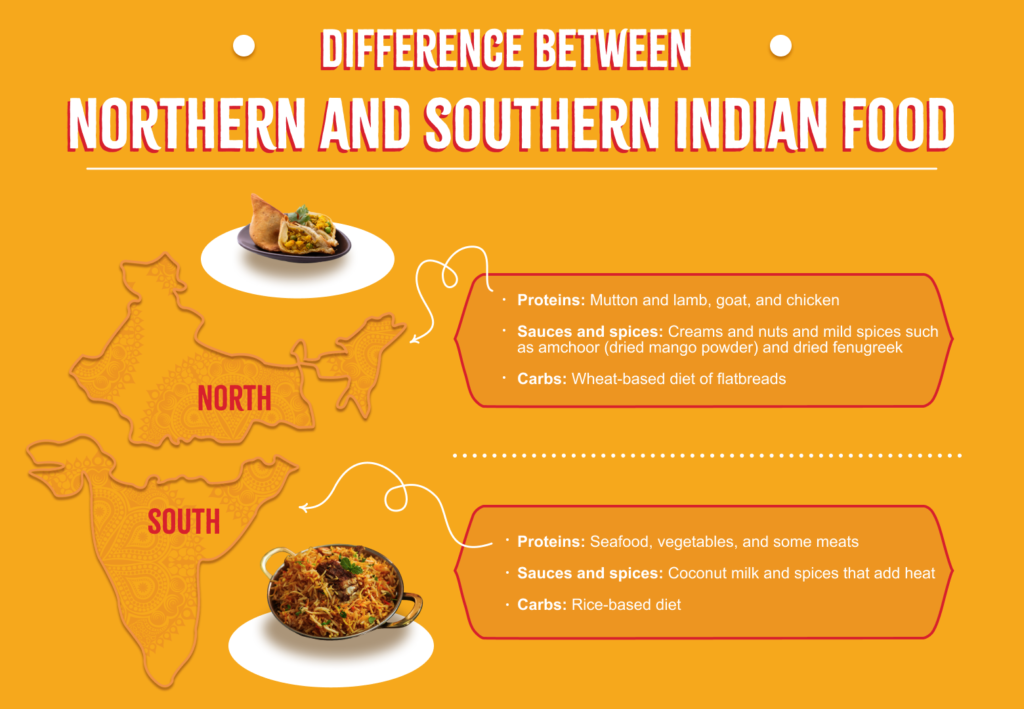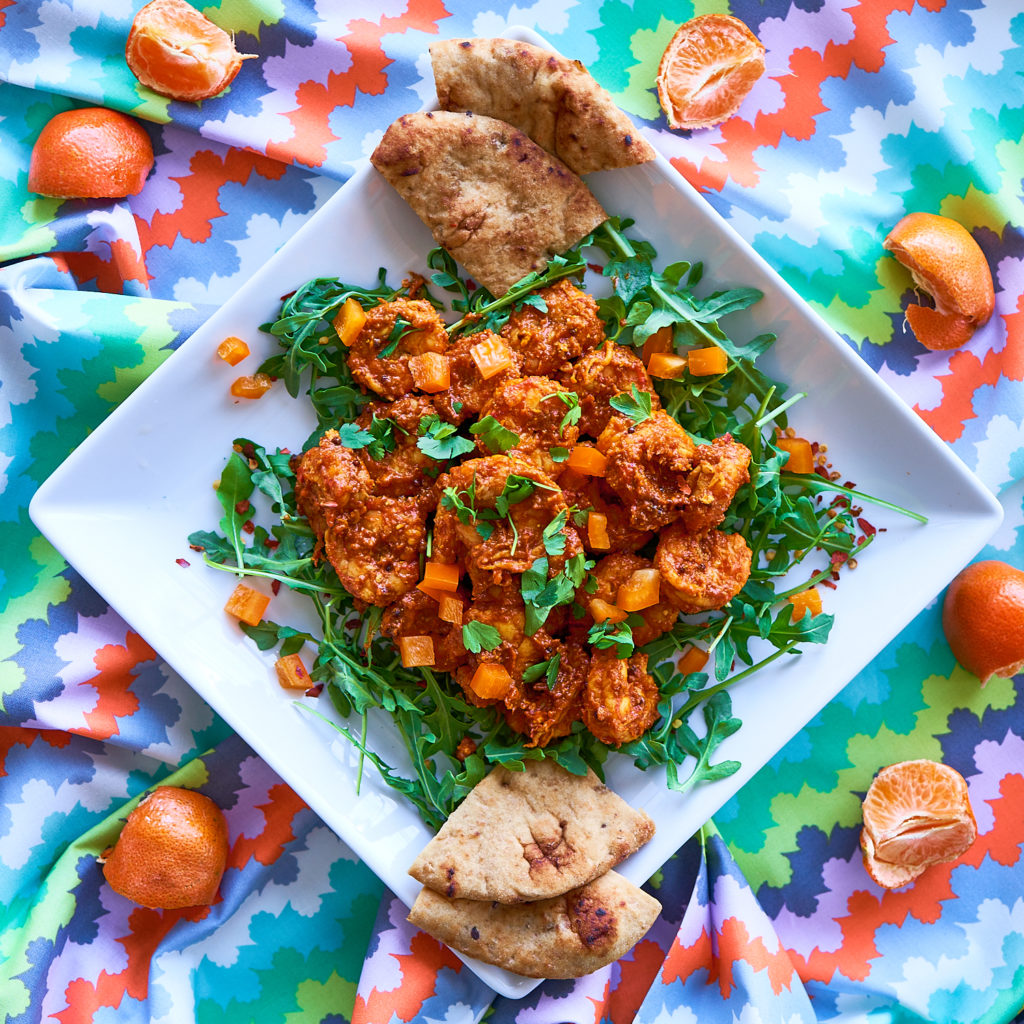The Differences Between Northern & Southern Indian Food

Claiming that all Indian food is the same is like trying to say that a Louisiana po’boy is comparable to the classic lobster roll of Maine.
American food generally consists of creams and butter, but you’ll still find that how dishes are prepared changes ever-so-slightly depending on where you are in the country; the same policy applies to Indian cuisine. Across India, there are many delicious dishes to choose from, varying from North to South.
Considering all cuisines across India to be the same can prevent you from understanding the intricacies of Indian cultures and can hinder you from finding your favorite dish or variation. You’ll find differences in how your meals are prepared and even what they’re made of from North to South and East to West.
If you’re a fan of Indian cuisine, you’ve probably proclaimed a few dishes as your favorite, but we assure you, there are still more to taste. Depending on the chef and kitchen, you may uncover a new style, recipe, or ingredient that gets you buzzing like never before.

Ingredients
One of the most considerable distinctions between Northern and Southern Indian foods is the commonly used ingredients. Within any country’s cuisine, you’ll find that dishes are mainly created based on what is grown in the region.
South Indian Ingredients
In South India, heavy rainfall and the Indian ocean allow beautiful fruits and vegetables to grow in abundance.
The coast offers delicious seafood, including sardines, Indian salmon, prawns, and tuna. With tons of fruits, vegetables, and seafood to choose from, you’ll notice South Indian cuisines are more often vegetarian or pescatarian-based. You can still find many meat dishes, but if you’re dining on the coast, we recommend you indulge in the rich seafood that surrounds you.
As a cooking agent, tropical coconut milk is frequently used for making curries. When it comes to spices, the South is known for hotter spice mixes made with Huli Pudi (sambar powder), tamarind, cinnamon, mustard seed, cardamom, nutmeg, clover, and dried curry leaves. Although the climate is already hot enough, South Indians use spices with more heat because it helps induce sweat and help the body cool down.
All of the delicious seafood, fruits, vegetables, and spices of the South are typically served over rice. Rice is a significant component of the South Indian diet. Because seafood and fruit are so low in calories, rice is a good energy source in the draining South Indian heat.
The foods and flavors produced by the South Indian climate define traditional South Indian cuisine. If you’re not sure what exactly to order when traveling in the South, lean towards dishes that showcase fruits, vegetables, and various fish; you’ll surely be pleased.
North Indian Ingredients
Further up north, you’ll find more ingredients that you’re accustomed to seeing in Indian restaurants outside of India.
North Indian food more commonly uses meat and dairy as the centerpiece of their dishes rather than seafood and vegetables of the South. The most frequently used meats are mutton and lamb, goat, and chicken. Beef isn’t as common in India as some Hindus regard cows as sacred animals.
Don’t be fooled; vegetables still have their place in Northern cuisine; just different ones take prominence. Spinach, mustard greens, radishes, and cauliflower are among some of the vegetables that can be found in everyday dishes.
Rather than using coconut milk, North Indian dishes are more often made using dairy cream and blended nuts. The North’s winter can be pretty frigid, so nuts and thick creams are the perfect way to add comfort and warmth to any dish.
Along with coconut milk being subbed out, South India’s spicier spices are replaced with North India’s more milder ones like amchoor (dried mango powder) and dried fenugreek.
Once the meats, vegetables, spices, and sauces are selected, North Indians will often enjoy their meal with a side of flatbread. Wheat grows in abundance in the Northern states, creating a more wheat-based than a rice-based diet. Enjoy fresh naan, roti, chapati, and several bread variations, all derived from the wheat grown right on the land.
The different crops and ingredients from each region allow the North and South to have their own specialty dishes and appetizers.
South Indian Dishes
South Indian dishes are consistently spicier and more tropical than traditional North Indian ones. Let’s talk about some classic South Indian appetizers and side dishes.

South Indian Appetizers and Sides
Accompanying your main dish, you’ll often be served sauces and rice and beans or lentils. There are several variations to simple sides, including biryani, daal, and raita.
Biryani is an aromatic mixed rice dish that’s made in several ways but often includes spices, meat, eggs, yogurt, and vegetables. Biryani is also found in North India, but there are variations specific to the South in cities like Hyderabad.
Coconut chutney is another option for taming heat. Chutney is a condiment you can make with pretty much any fruit or vegetable, but the South’s tropics grow large and flavorful coconuts that make for a great chutney. Serve this chutney as an accompaniment to dosas, idlis, or a variety of South Indian dishes.
Idli is one of the most popular breakfast sides enjoyed in the South. Idli are savory and light steamed cakes made with a fermented rice and lentil batter. The cakes are fluffy yet filling and can be served with any sambar or chutney you’d like.
South Indian Entrees
Masala dosa and appam are South Indian recipes that resemble pancakes or crepes. Masala dosa is made using a batter of soaked rice and lentils and is typically topped with grated coconut and chopped coriander. Appam is made from a batter of rice flour and coconut milk and is usually bowl-shaped. Both pancake-like dishes are used to host various ingredients like potatoes, mustard seeds, or fish; and can be eaten at any time of the day.
Sambar is a popular stew prepared with tamarind-based broth, turmeric powder, lentils, and vegetables. The dish is traditionally served with steamed rice or lentil side dishes. Of course, not all sambar recipes will taste the same, but most are spicy and tangy.
Pulihora is a South Indian rice dish that is served during festivals and celebrations in the Hindu culture. Pulihora is flavored with turmeric, tamarind, curry leaves, coriander, ginger, and green chiles for spice. Frequently, yellow lentils, roasted sesame seed powder, and mustard seeds are added to enhance the dish’s flavors. The word ‘puli’ means sour, reflecting the tangy taste of the dish.
Lemon rice is a South Indian staple that can be eaten on its own or laid as the foundation for your proteins and sauces. As you can imagine, lemon rice is zesty and works perfectly for bringing brightness to your plate.
North Indian Dishes
Let’s dive into some Northern recipes and see if you recognize them or if they’re something new you’d like to give a try.
North Indian Appetizers and Sides
In North India, wheat takes prominence over rice and lentils, and restaurants often serve you naan and flour-based sides.
Naan is a traditional flatbread that resembles pita. Naan is made of wheat flour and butter combined and leavened but can also be Tandoor-grilled or Tawa-fried. Naan can be served beside curries and stews or slathered with various chutneys.
Samosas are fried or baked pastries that are filled with savory ingredients. Samosas aren’t exclusive to North India and can be found in the local cuisines of South Asia, the Middle East, Central Asia, East Africa, and other regions. Samosas can be filled with meat or vegetarian options, and many include chutneys for extra moisture and flavor.
Seekh Kebabs are delicious kebabs that can be made of various ground meats but are more commonly made with lamb. The ground meat is seasoned with garam masala, cumin seeds, fresh ginger, cilantro, and other spices and mixed until thoroughly combined. Then, the meat is rolled into a sausage-like shape and grilled to be served with raw red onion and mint-cilantro chutney.
North Indian Entrees
North Indian entrees are made using lots of creams, sauces, and meats. Although less spicy, North Indian food is still filled with spices that add tons of flavor and layers to every dish.
Aloo gobi is made by frying potatoes, cauliflower, or both and adding it to gravy or curry. The dish is often yellow in color because of turmeric’s presence, but depending on what curry it’s placed in, it can take any color. Aloo gobi is a great vegetarian entree that’s delicious, hearty, and filling.
Chicken tikka masala is a bright and flavorful Indian dish that’s made its way across the globe. One bite of this smooth and velvety dish will remove all questions about why it’s grown so popular. Boneless pieces of chicken are marinated in yogurt and spices and then roasted. Once roasted, the chicken is placed in a rich and spicy gravy that can be placed over rice or served with naan.
Malai kofta is a delicious and creamy Northern Indian dish that’s simple yet flavorful. The dish is made with fried balls of paneer, potato, and mixed vegetables served in a creamy gravy made of chopped tomatoes, onions, blended nuts, and of course, spices.
The Vast World of Indian Food
Indian food is just as diverse as any other culture’s foods. From the North to the South, you’ll find unique recipes for each region you visit, but there are also qualities that every region shares.
What’s great about globalization is that cuisines are becoming universally available and are even modernizing to incorporate cooking methods and flavors of other cultures. Sukhi’s Indian cuisine is bringing your favorite Indian dishes to American plates.
You can enjoy chicken tikka masala, chicken coconut curry with mango, potato samosas, chicken biryani, and even veggie turmeric naanwiches, all in the comfort of your home. Our differences are what allow for innovation and creativity while still sharing authentic Indian spices and flavors.
Northern and Southern Indian foods don’t have to be a mystery. With one quick scan through the Sukhi database of recipes, you can always find new and delicious flavors and recipes inspired by Indian cuisine.

4 responses to The Differences Between Northern & Southern Indian Food
thank you for sharing about the variations in the northern and southern indian dishes! i love learning about cultures and food. Sukhi’s food is great and i love all of the wonderful flavors.
Thanks, Daniela! Indian food is so diverse and delicious. We appreciate that you like learning about it and trying new dishes!
[…] With delicious deep-fried dumplings dunked in mouthwatering curry, it’s no wonder that malai kofta is one of the most popular dishes in Northern Indian cuisine. […]
[…] you’re waiting for your order to arrive, browse our blog to learn about the differences between Northern and Southern Indian cuisine along with dozens of Indian recipes for your family to appreciate and […]